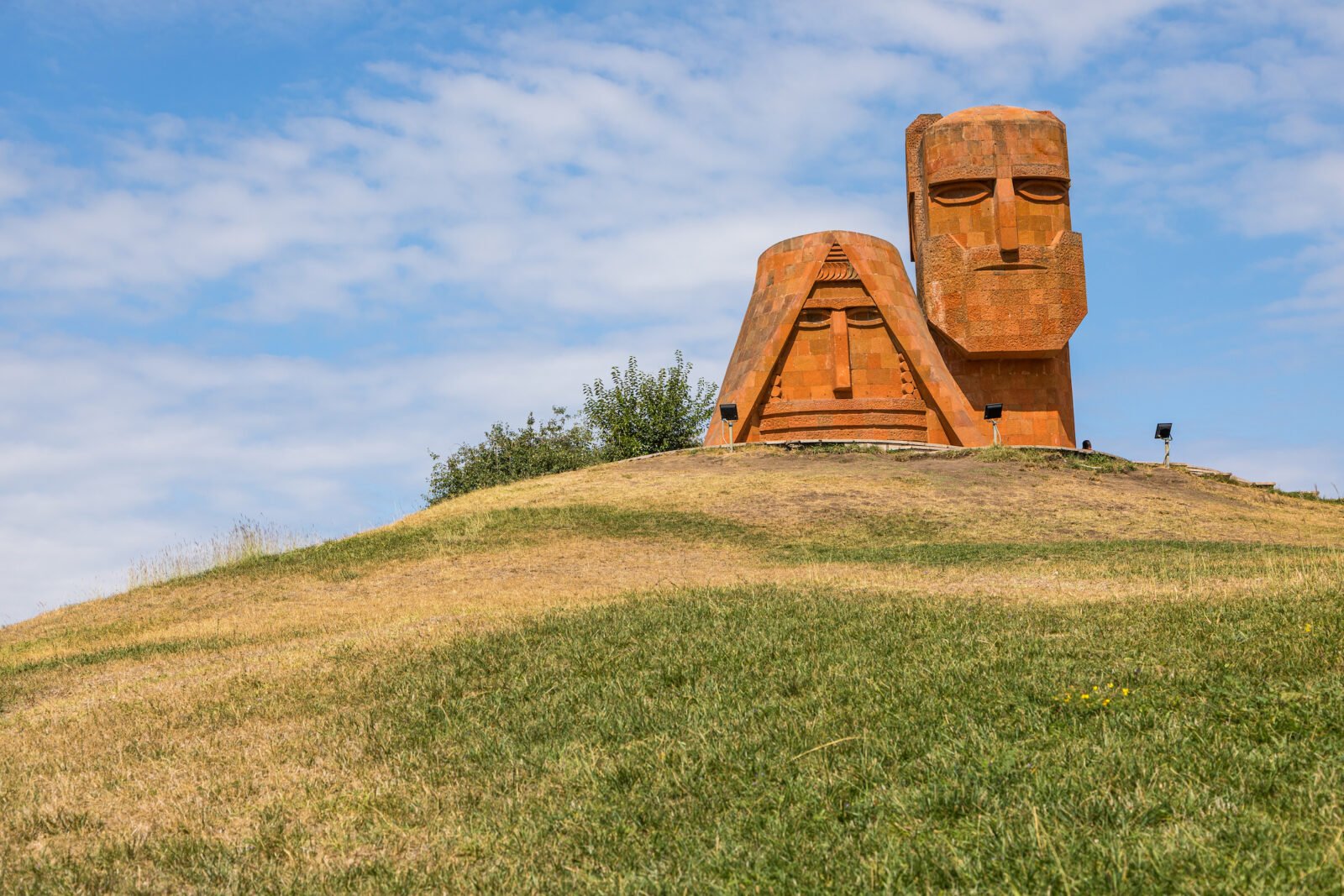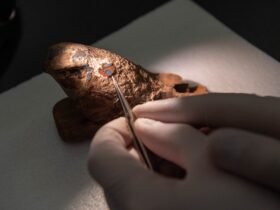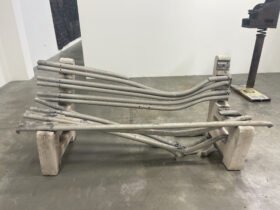A few weeks ago, dozens of photos of the ‘We are our mountains’ (‘Tatik-Papik’) monument in occupied Artsakh disappeared. Wikimedia Commons. A red text box appeared warning against uploading new images that prominently feature the monument because it is located in “a country that does not offer Wikimedia Commons-acceptable panorama freedom.” The monument, composed of volcanic tuff and weighing thousands of kilos, had obviously not been moved. But the surrounding, invisible boundaries, and therefore the applicable copyright laws, had changed.
At the end of last year, after a illegal blockade For more than nine months, Azerbaijan launched a military offensive and violently uprooted the indigenous Armenian population of Artsakh – actions that are widely recognized as genocidebut has so far been carried out with impunity. Most people fled, leaving behind personal belongings, including photo albums. They rely on Facebook posts or photos they find on the Internet to revisit the places they remember.
After the occupation of Artsakh (also known as Nagorno-Karabakh), Azerbaijan continued its long-standing policy of destroying Armenian cultural heritage, starting with the relatively “newer” (18th to 19th century) religious and cultural sites, such as experts say. predicted it would happen. In the city of Stepanakert, the former capital of the Republic of Artsakh, which Azerbaijan recently renamed “Khankendi”, Azerbaijan recently razed to the ground several 19th century buildings on the historic Tumanyan Street and whitewashed buildings made of tuff, presumably because this pink to reddish tinged rock is associated with Armenian architecture. In line with the eradication of not only the physical Armenian presence from Artsakh, but also any evidence thereof, Azerbaijan has also renamed most Stepanakert streets, including by dedicating one to Enver Pasha – a failed Ottoman Turkish Minister of War, who also happens to be one of the main architects of the Armenian genocide and a proponent of pan-Turkism (he supported the creation of the Azerbaijan Democratic Republic as an outpost of the crumbling Ottoman Empire in the Caucasus).
Currently, the monument ‘We are our mountains’ still stands. It was created in 1967 by Sargis Baghdasaryan, modeled after his grandparents, who were also from Artsakh. It became a symbol of the region and of the Armenian indigenous population and resistance to the occupation, and was later included on the coat of arms of the Republic of Artsakh after its inhabitants voted in referendum independence in 1991. The monument shows an elderly man and woman standing shoulder to shoulder from a hilltop, as if they were one. of the country and by the country. The grandmother – or ‘Babo’ in the Artsakh dialect of Armenian (‘Tatik’ in Eastern Armenian) – wears a traditional face covering, which was a symbol of modesty and indicative of the cultural norm of silence imposed about Armenian women getting married.
Azerbaijani propagandists on Tat) – I clearly don’t understand that the subjugation of women is rooted in patriarchal elements that transcend religion. Azerbaijan, a petro-dictatorship are infamous for own laws silencing reporting and social discussion, decided to do so darken the monument rather than destroying it completely. It is possible that Azerbaijan understands that reusing such symbols can be as psychologically damaging as destroying them. (It’s also possible that destroying it isn’t a priority.)
But should Wikimedia Commons comply with requests to remove photos from ‘We Are Our Mountains’? It depends.

Freedom of Panorama is an exception to copyright law, which otherwise requires permission (a license, with credit and/or payment) from the original artist of a work before anyone can copy or reproduce it, for example by photographing it. Different countries have different approaches to the Freedom of Panorama; for example players ‘catch’ Pokémon for monuments in Italy or Denmark may infringe on the copyrights of artists or architects, but the same behavior is probably fine in the United Kingdom and the United States, where photographs in public spaces are generally allowed without restrictions. Wikimedia is no stranger to these nuances: it has been sued for posting photos of works in public spaces, as in the 2016 case Bildkonst Uphovsrätt i Sverige (BUS) against Wikimedia Sverigewho lost it.
In response to HyperallergicWhen asked for comment by the Wikimedia Foundation, a spokesperson for the Wikimedia Foundation noted in a statement that it “does not control what content is included, or how content is maintained, on Wikimedia Commons or other Wikimedia projects.” Instead, the spokesperson noted, the content is “determined by a global community of volunteer contributors, who also policies and guidelines for the website.”
The spokesperson’s statement continued:
For example, Wikimedia Commons has a ‘precautionary principle‘ which says: ‘if there is serious doubt about the freedom of a particular file, it should be deleted.’ In the specific case you are investigating, we can share the volunteer-written advice on freedom of panorama from Wikimedia Commons Azerbaijan And Artsakh/Nagorno-Karabakhwhich advised that images of monuments from both places were not permitted. Because decisions about Commons are made through discussion and consensus, a practice shared by Wikimedia projects, volunteers followed this advice and removed the images. The Wikimedia Foundation, among several affiliated organizationshave advocated the universal acceptance of panoramic freedom throughout Europe for several yearsincluded in anticipation of the 2019 EU Copyright Directive.”
While Copyright law of Azerbaijan allows reproduction of “works of art permanently located in a public space” without license and without fee, under Article 20 the copyrighted work cannot be “the principal feature” of the reproduction and the reproduction cannot be used for commercial purposes purposes. This means that a person likely cannot photograph a sculpture and upload the image to Wikimedia Commons if the sculpture is prominently featured in the photo.
Less simple, however, is the question of whether Baghdasaryan’s sculpture is even protected under Azerbaijan’s copyright regime; you could say that the work is in the public domain. According to Article 27 of the Azerbaijani Copyright Law, “a work that has never enjoyed protection on the territory of the Republic of Azerbaijan is considered to be in the public domain.” The image was taken in 1967, in the then Nagorno-Karabakh Autonomous Oblast, not in the Republic of Azerbaijan (which did not yet exist until 1991).
Moreover, an independent Azerbaijan has never been complete until last year de jure or de facto control over the area, including where the monument is located. When Azerbaijan seceded from the Soviet Union, the country rejected its legal Soviet heritage, which included the Autonomous Oblast of Nagorno-Karabakh – formed by Stalin himself and placed within the borders of the Azerbaijani SSR – and instead declared itself to successor state. of the de facto, self-declared and unrecognized Democratic Republic of Azerbaijan, which existed from 1918 to 2020.
Ironically, if the late Baghdasaryan (or his estate) is the copyright holder, Azerbaijan’s misappropriation of the sculpture could violate the broad moral rights Azerbaijan grants to creators under Article 14 of the Copyright Act, including the right to object to distortion or other changes to the work that are detrimental to the author’s reputation. (Similar language about “honor” and “reputation” appears in the US Visual Artists Rights Act as well as the Berne Convention.)

While Article 16 of the Constitution of Azerbaijan imposes on the state the duty to protect historical, tangible and intangible heritage, Azerbaijan is notorious for its selective application of such responsibilities.
For example, Azerbaijan is ignoring many of its obligations as a party to the Convention on the Elimination of All Forms of Racial Discrimination (CERD), including various interim measures by the International Court of Justice regarding discrimination against Armenians and the Armenian cultural heritage. Azerbaijan maintains a broad ban on anyone of Armenian ethnicityregardless of their nationality, enter the country, as well as anyone who visited Artsakh before the end of 2022 (i.e. without the “permission” of Azerbaijan). At present, there is no one in Azerbaijan who could safely defend the rights of an Armenian artist or monument, even if these rights were theoretically recognized by the state itself.
In the run-up to next week COP29the annual United Nations Climate Change Conference held this year in Azerbaijan – even though oil and natural gas account for more than 90% of its exports – has left the country extended the pre-trial detention of more than eleven journalists. Azerbaijan continues to illegally detain dozens of ethnic Armenian prisoners of war, including many officials of the Republic of Artsakh. This “pre-trial detention” is in addition to the mock tests of Vagif Khachatryan, an elderly Armenian citizen whom Azerbaijan kidnapped from a Red Cross ambulance in 2023, and others civilians captured and later tried, like Rashid Beglaryan and Vigen Euljekian, when Azerbaijan’s actual borders shifted.
It seems that even in the digital age, where information crosses borders, countries like Azerbaijan are not only allowed to physically exclude Armenians from their homeland, but also have the privilege of interfering with Armenians’ collective ability to mourn and remember the places they come from. they have been driven away.
Maria T. Cannon, an attorney at Ambart LLC, contributed reporting for this story.
Editor’s note 11/8/24 3:54 PM EDT: This article has been updated with a statement from a spokesperson for the Wikimedia Foundation.













Leave a Reply